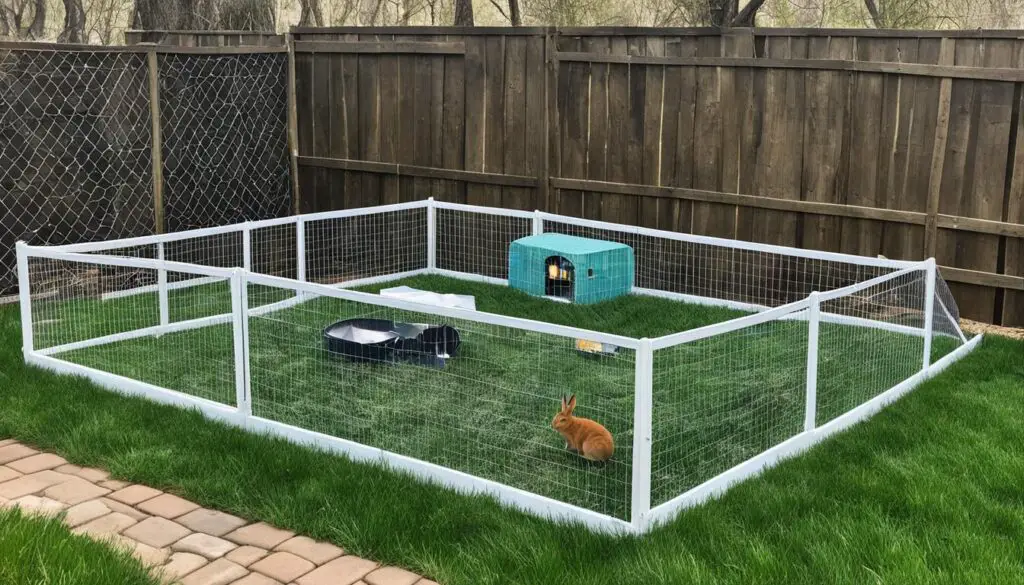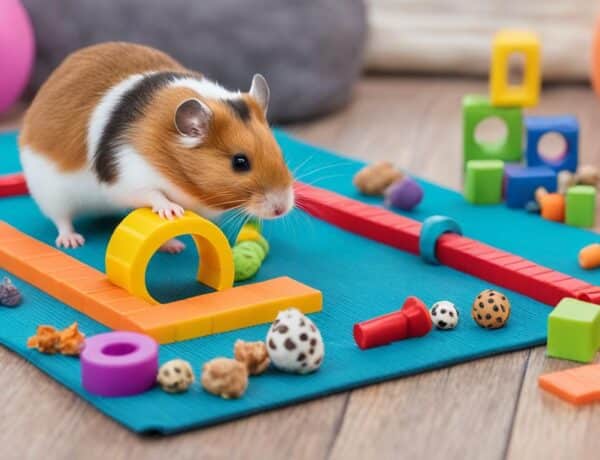Hello, rabbit owners! If you have noticed your furry friend displaying signs of aggression or territorial behavior, you may be wondering how to address this issue and create a peaceful environment. In this article, I will share effective strategies to prevent aggression in rabbits and help you understand and manage their territorial instincts. By implementing these strategies, you can ensure the well-being of your beloved rabbits and foster a harmonious bond with them.
Key Takeaways:
- Understanding the signs of rabbit aggression is crucial in providing a safe environment.
- Rabbits may exhibit aggression when feeling threatened, afraid, or in pain.
- Hormonal changes during breeding season can contribute to territorial aggression.
- Neutering can help reduce hormonal aggression in rabbits.
- Giving rabbits enough space, hiding places, and a neutered companion can create a safe environment.
Signs of Rabbit Aggression
Rabbits are highly expressive animals that communicate primarily through non-verbal cues and body language. Understanding the signs of aggression in rabbits is crucial for ensuring their welfare and preventing potential conflicts. Here are some key indicators to watch out for:
- Crouching down or hiding: When a rabbit feels threatened or stressed, it may exhibit defensive behavior by crouching down or seeking hiding spots to protect itself.
- Grunting: An aggressive rabbit may emit low grunting sounds as a warning to others or to establish its territorial boundaries.
- Screaming: In extreme cases of fear or distress, rabbits may let out piercing screams, indicating their heightened state of fear.
- Raising their front paws: Rabbits might raise their front paws to signal a defensive stance, indicating their readiness to attack if necessary.
- Baring their teeth: When a rabbit bares its teeth, it’s a clear sign of aggression and a warning to stay away.
- Lunging or nipping: Aggressive rabbits may lunge forward or nip at their perceived threats as a way to establish dominance or protect themselves.
- Thumping: Rabbits have a unique ability to thump the ground with their hind legs when they sense danger, alerting others to potential threats.
- Flicking their back feet: Rabbits may flick their back feet rapidly to signal agitation or irritation, indicating their readiness to defend themselves.
When observing these signs of aggression in rabbits, it’s important to prioritize their safety and well-being. Providing rabbits with space and time to calm down is crucial to avoid further distress or injury. Additionally, seeking professional advice from a veterinarian or animal behaviorist can help address any underlying issues contributing to the aggressive behavior.
Understanding the Context of Non-Verbal Cues
Rabbits’ body language can vary based on the specific context and individual personality traits. For example, a rabbit might exhibit aggressive behavior towards an unfamiliar rabbit but be calm and affectionate towards its bonded mate. Therefore, it’s essential to consider the overall situation and the specific rabbit’s behavior patterns when interpreting non-verbal cues.
Creating a Safe Environment for Rabbits
By understanding the signs of aggression in rabbits, owners can take proactive steps to prevent conflicts and ensure the well-being of their furry friends. Providing rabbits with sufficient space, mental stimulation, and positive interactions can help minimize stress and reduce the likelihood of aggressive behavior.
| Preventive Measures | Benefits |
|---|---|
| Spacious living area | Allows rabbits to establish their territory and reduces the risk of territorial disputes. |
| Enrichment activities | Provides mental stimulation and outlets for natural behaviors, reducing boredom and frustration. |
| Neutering | Helps reduce hormonal aggression and territorial behavior in both male and female rabbits. |
| Patient and gentle handling | Builds trust between rabbits and their owners, minimizing fear and defensive behaviors. |
| Conflict resolution techniques | Teaches rabbits how to interact and resolve conflicts peacefully, preventing escalated aggression. |
Causes of Rabbit Aggression
Aggression in rabbits can be triggered by various factors, including fear, pain, hormonal changes, and territorial behavior. Understanding these underlying causes is crucial for effectively managing and preventing aggression in your rabbits.
Fear and Pain
Fear: Rabbits are prey animals, and they have a natural instinct to protect themselves when they feel threatened. Fear can arise from various sources, such as loud noises, sudden movements, or unfamiliar environments. When rabbits are afraid, they may exhibit aggressive behaviors as a way to defend themselves.
Pain: Rabbits, like any other living creatures, can experience pain, whether from injury, illness, or discomfort. When rabbits are in pain, they may become defensive and display aggression as a result of their instinctive fight-or-flight response.
It is essential to create a safe and secure environment for your rabbits, minimizing potential sources of fear and ensuring their overall well-being. Additionally, providing regular veterinary care and promptly addressing any signs of pain or discomfort can help prevent aggressive behavior stemming from fear and pain.
Hormonal Changes and Breeding Season
During the breeding season, rabbits undergo significant hormonal changes that can contribute to increased aggression. As they seek to establish their territory and attract mates, rabbits may display territorial behavior and become more prone to aggression towards other rabbits or potential rivals.
Neutering is a highly recommended solution for reducing hormonal aggression in rabbits. By neutering your rabbits, you can help regulate their hormonal levels and temper territorial behaviors, promoting a more stable and peaceful environment for them.
Territorial Behavior
Rabbits are naturally territorial animals, and they have a strong urge to protect and defend their space from intruders. This territorial behavior can manifest as aggressive actions, such as lunging, biting, or marking their territory with urine.
To minimize territorial aggression in rabbits, providing each rabbit with enough space and separate territories can be beneficial. This helps prevent conflicts and reduces the need for rabbits to compete for resources or establish dominance.
| Causes of Rabbit Aggression | Measures to Prevent and Manage Aggression |
|---|---|
| Fear and Pain | Creating a safe environment, identifying and addressing sources of fear and pain, regular veterinary care |
| Hormonal Changes and Breeding Season | Neutering, providing environmental enrichment, minimizing triggers for aggression |
| Territorial Behavior | Providing enough space and separate territories, introducing rabbits gradually, promoting positive interactions |
Understanding the causes of aggression in rabbits is the first step towards effectively managing their behavior and ensuring their well-being. By addressing fear and pain, regulating hormonal changes through neutering, and providing appropriate environmental conditions, you can create a harmonious and peaceful environment for your rabbits.
Quote:
“Aggression in rabbits can stem from fear, pain, hormonal changes, and territorial behavior. By addressing these underlying causes, rabbit owners can create a secure and peaceful environment for their furry companions.” – Veterinary Specialist, Dr. Emily Rodriguez
Why Do Rabbits Bite?
Rabbits may bite when they feel threatened or afraid. It is important to understand the reasons behind their biting behavior in order to prevent it and ensure the well-being of your furry friend.
One of the main reasons for rabbit biting is the fear response. When rabbits feel scared or anxious, they may resort to defensive behavior, including biting. This can be triggered by various factors, such as excessive handling, chasing, looming over them, or restraining them forcefully.
Lack of space or hiding places can also contribute to rabbits feeling trapped and resorting to aggressive biting. If rabbits do not have enough room to move around or adequate hiding spots, they may perceive their environment as threatening, leading to defensive behavior.
To prevent biting behaviors, it is crucial to provide rabbits with a safe and secure environment. This includes giving them enough space to roam, play, and exercise. Additionally, ensuring that there are plenty of hiding places, such as tunnels or shelters, gives rabbits the option to retreat when they feel the need to.
| Reasons for Rabbit Biting | Preventive Measures |
|---|---|
| Fear response due to feeling threatened | Handle rabbits gently and avoid actions that scare or stress them |
| Lack of space or hiding places | Provide rabbits with ample space for movement and hiding spots |
| Uncomfortable or painful physical condition | Regularly check and address any health issues or discomfort |
| Unfamiliar or stressful environment | Introduce rabbits to new environments gradually and minimize sudden changes |
By addressing the reasons behind rabbit biting and implementing preventive measures, you can create a safe and comfortable environment for your rabbits, reducing the likelihood of aggressive behavior.
Creating a Safe Environment for Rabbits
Rabbits are social animals that thrive in the company of others. Providing them with rabbit companionship can greatly contribute to their well-being and help prevent aggression. It’s essential to ensure that rabbits feel settled in their territory and have enough space and hiding spaces to feel secure and avoid feeling trapped.
Slow interactions play a crucial role in gaining a rabbit’s trust. Approaching rabbits calmly and at their level helps them feel more comfortable and less threatened. Engaging in slow movements and allowing rabbits to approach you at their own pace can build a bond based on trust and reduce the likelihood of aggression.
Hiding spaces are vital for rabbits as they offer a sense of security and a place where they can retreat when feeling stressed or overwhelmed. These hiding spaces can be in the form of tunnels, boxes, or caves placed throughout their environment. By providing rabbits with multiple hiding spots, you create an environment that promotes their natural instinct to feel safe and secure.
“Creating a safe environment that prioritizes rabbit companionship, settling in their territory, providing hiding spaces, and focusing on slow interactions plays a vital role in preventing aggression and ensuring rabbits’ well-being.”
| Rabbit Companionship | Settling in Their Territory | Hiding Spaces | Slow Interactions | Gaining Trust |
|---|---|---|---|---|
| Rabbits thrive in the company of other rabbits. Providing them with a neutered partner can prevent feelings of loneliness and reduce the risk of aggressive behavior. | Giving rabbits a dedicated space that they can call their own helps them feel more secure. This can be achieved by setting up a rabbit-friendly area with toys, food, and comfortable bedding. | Hiding spaces offer rabbits a sense of security and a place to retreat when they need space or want to feel safe. Tunnels, boxes, and caves can serve as hiding spots throughout their living environment. | Approaching rabbits slowly and calmly allows them to feel more at ease and less threatened. Slow interactions help build trust and strengthen the bond between humans and rabbits. | Gaining a rabbit’s trust takes time and patience. Offering treats, talking softly, and avoiding sudden movements can help rabbits feel more comfortable and develop trust in their human caretakers. |
By following these strategies, you can create a safe and nurturing environment for your rabbits, promoting their physical and mental well-being while minimizing the risk of aggression. Remember, every rabbit is unique, and it’s essential to observe their individual preferences and needs to provide them with the best possible care.
Conclusion
Preventing aggression in rabbits requires a proactive approach from us as responsible owners. By understanding their behaviors and addressing underlying causes, we can create a safe and enriching environment that promotes peace and harmony.
A key strategy in preventing aggression is neutering. This helps to minimize hormonal changes that can contribute to territorial behavior. Additionally, providing adequate space and hiding spots allows rabbits to feel secure and avoid feelings of being trapped or threatened.
Building trust with our rabbits is essential. Slow interactions, approaching calmly, and offering treats help establish a bond and reduce anxiety. However, if aggression persists despite our best efforts, it is important to seek professional advice.
I recommend reaching out to the Rabbit Welfare Association & Fund or a registered behaviorist who specializes in rabbits. These experts can provide personalized guidance and support to address specific aggression issues. Remember, seeking professional advice shows our commitment to the well-being of our beloved rabbits.
FAQ
How can I prevent aggression in rabbits?
To prevent aggression in rabbits, it’s important to understand their behaviors and address underlying causes. Strategies such as neutering, providing adequate space and hiding spots, and building trust with your rabbits can help prevent and manage aggression.
What are the signs of aggression in rabbits?
Rabbits communicate their aggression through non-verbal cues and body language. Signs of aggression include crouching down or hiding, grunting, raising their front paws, baring their teeth, lunging or nipping, thumping, and flicking their back feet.
What causes aggression in rabbits?
Fear and pain are common underlying causes of aggression in rabbits. Hormonal changes during the breeding season can also contribute to aggression, as rabbits try to defend their territory and warn off rivals.
Why do rabbits bite?
Rabbits may bite when they feel threatened or afraid. Chasing, looming over, or restraining rabbits can scare them and provoke defensive behavior. Lack of space or hiding places can also make rabbits feel trapped, leading to aggressive biting.
How can I create a safe environment for rabbits?
Rabbits thrive in a safe environment where they have the companionship of a neutered partner. Providing rabbits with enough space and hiding spots, and approaching them calmly and slowly can help create a bond and prevent aggression.
Where can I seek professional advice for managing aggression in rabbits?
If aggression persists, it is recommended to seek advice from the Rabbit Welfare Association & Fund or a registered behaviorist. They can provide guidance and support in managing aggression in rabbits.







No Comments